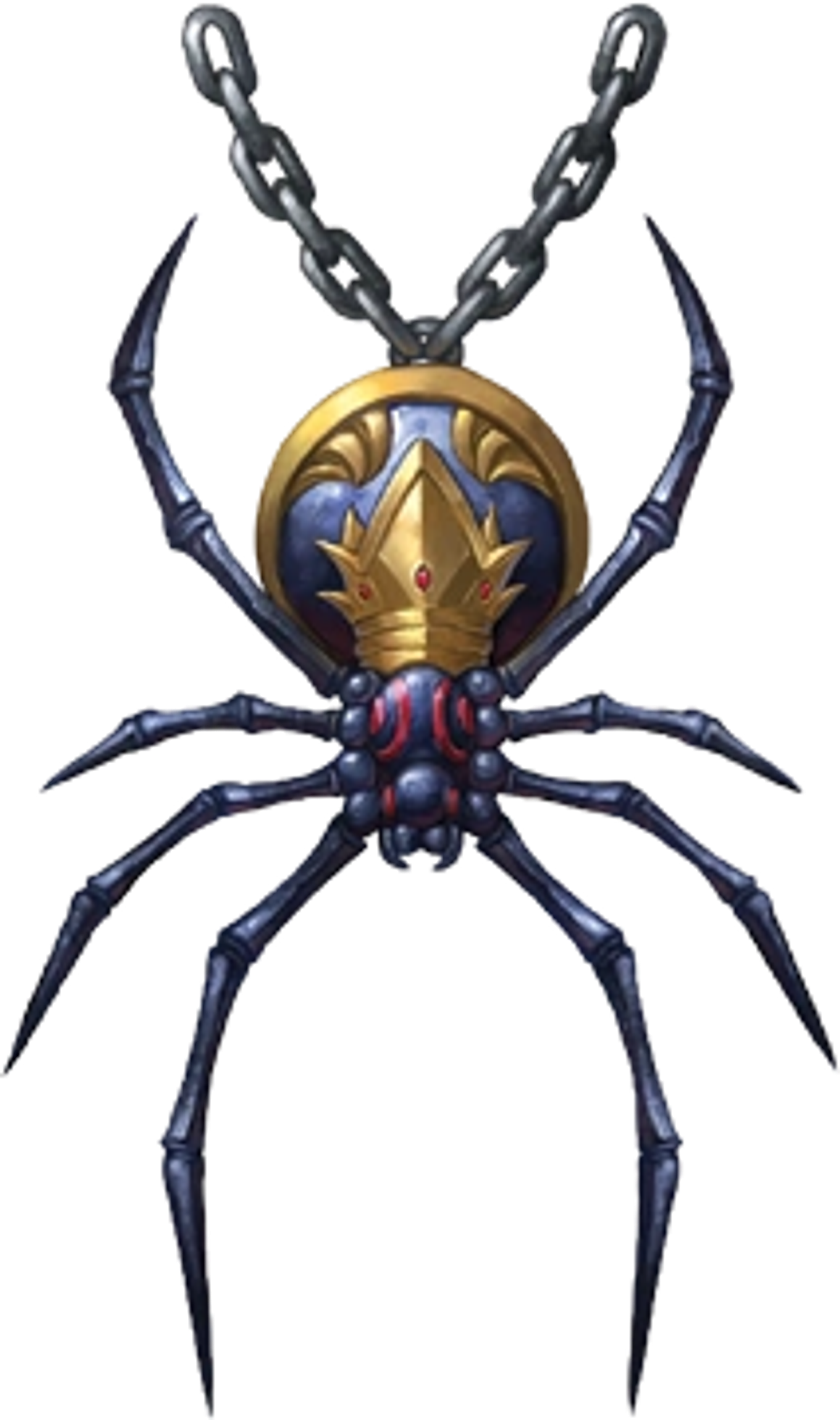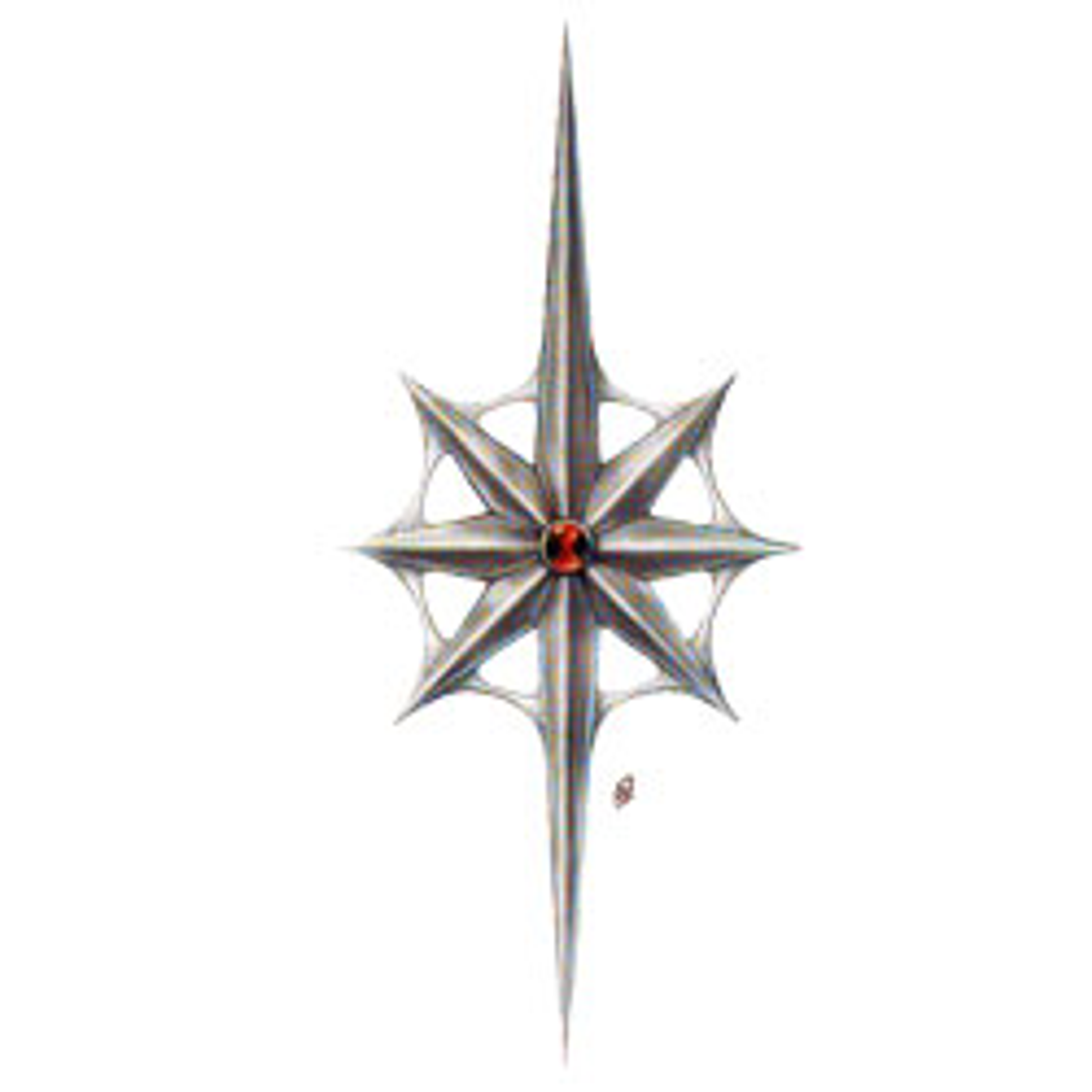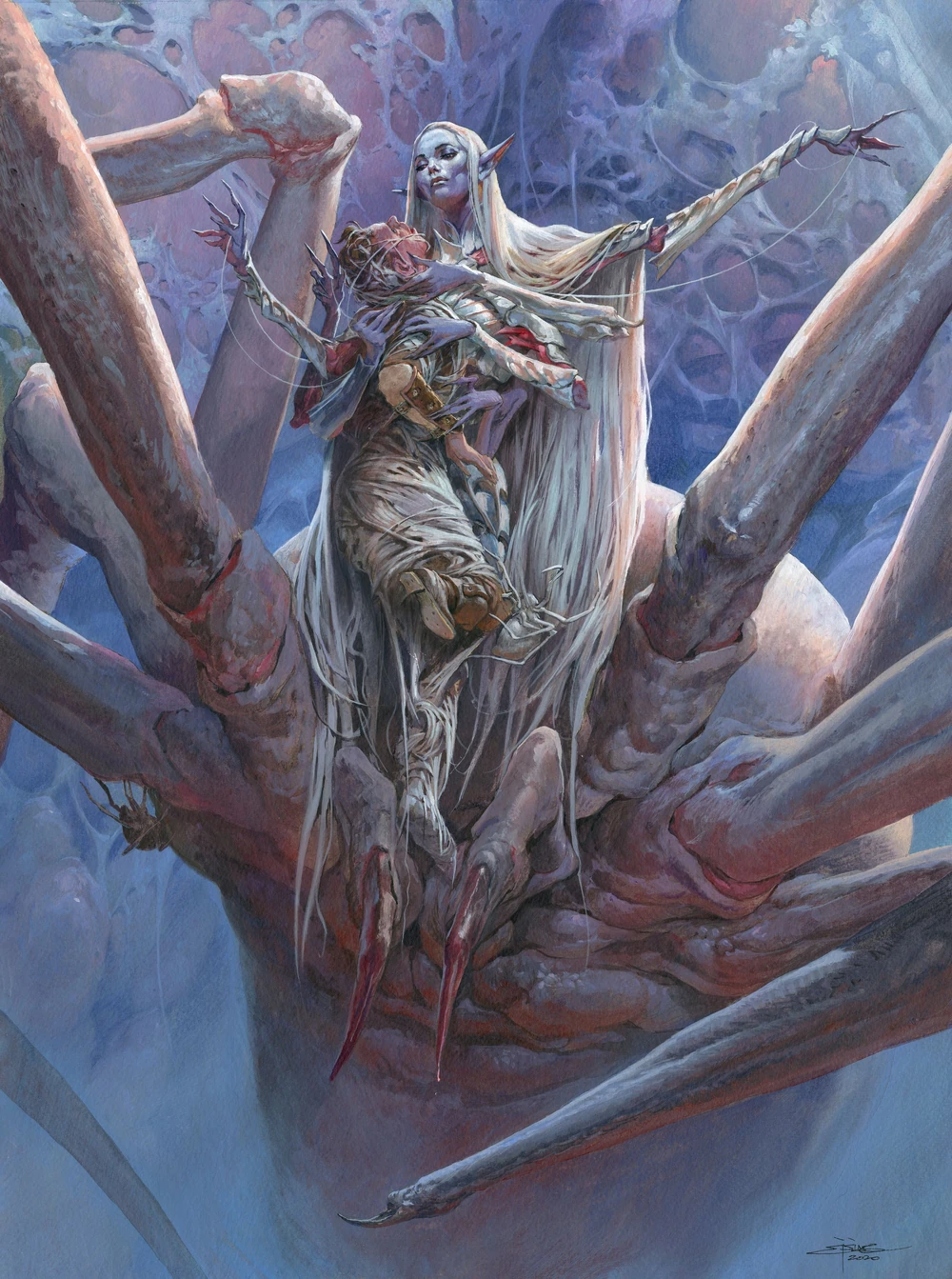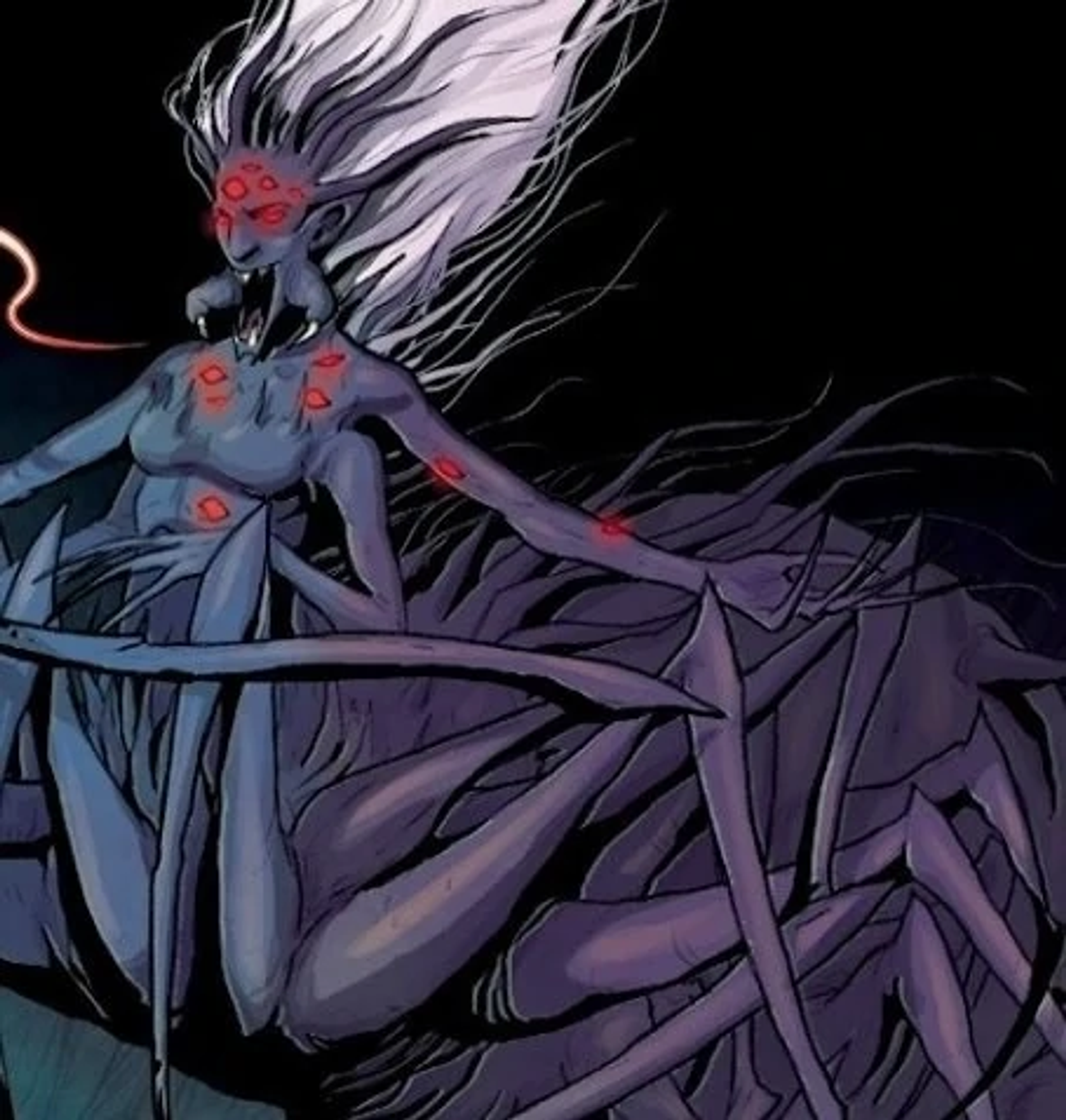Lolth, Goddess of Spiders and Lies - The Spider Queen (LE)
“Oh, poor, deluded thing. Your gods have sent you to your doom, knowing full well you could not survive an encounter with me. I see the fear in your eyes, the doubt gnawing at your heart, and the countless lives claimed by your blade in the name of other gods. Do you ponder whether to fall to your knees and worship me? Or perhaps flee in terror? Maybe you hope to cower behind your walls and strongholds? Understand this: the best you can do is beg for mercy, for your gods will not come to your aid. They are the ones who abandoned you to this fate, after all.
Yet I alone see your true potential—the power you could wield, the intricate webs you could weave, the deceit you could master, and the path to greatness that lies before you. So, what will it be, mortal? Will you offer me your love—or your life?” — Lolth, meeting a paladin.
Culture Names
| Culture | Name | Title | Pronouns | Group |
|---|---|---|---|---|
| Alonian (Tallman) Generic | Lolth | The Spider Queen | She/Her | The Defiant Gods |
| Asteni (Tallman) Italian | Tejedora | The Weaver of Lies | She/It | Gli Dei Sfidanti (The challenging gods) |
| Dal (Tallman) Hispanic | Aracnia | The Deceiver of Silk | She/Her | Los Desafiantes (The challengers) |
| Duir (Dwarven) German | Weberin | The Ensnaring Web | She/They/It | Die Gegner (The opposers) |
| Dwelmer (Dwarven) Nordic | Arachna | The Eight-Legged Ruler | She/They/It | Vanróg Gudar (Deifying gods) |
| Eldar (Elven) Elven | Ungoliant | The Demon Spider | She/They/It | Vaiar (Tyrants) |
| Eldarin (Elven) Japanese | Jorogumo | The First Drow | She/Her | Akugami (Evil deities) |
| Mularir (Tallman) Greek | Arachne | The Schemer in Silk | She/Her | Thymo theoí (Wrath gods) |
| Yotunn (Dwarven) Giant | Arakna | The Great Spider | She/They/It | Gegn Guir (The Gods against) |
Extra Titles
The Spider Queen: Lolth, Goddess of Spiders The Lady of Deception: Lolth, Goddess of Lies The Matriarch of Darkness: Lolth, Goddess of Betrayal The Queen Weaver: Lolth, Goddess of Trickery
Commandments
- It is better to be loved than feared, but you may certainly try to be both.
- Misdirection, slander, and shadowed steps have more function than direct conflict.
- Death to the elves who live under the sun, and death to all their allies!
Portfolio
- Spiders: Lolth is the mistress of spiders, commanding legions of arachnids and granting them her divine favor to weave intricate webs and ensnare prey.
- Deception: She embodies cunning and deceit, teaching her followers the art of manipulation and treachery to achieve their ambitions.
- Darkness: Lolth rules over the darkness, shrouding her realm and the hearts of her followers in shadow, where secrets and malice thrive.
- Control: Lolth revels in taking control of others, specially against their desires, puppeteering others to achieve their goals she is the matriach of leaders that aim to seize every part of their domains.
- Drow: Lolth is the matron deity of the drow, guiding their matriarchal society with an iron fist, where ambition and ruthlessness are rewarded.
- Silk: She is the patron of silk and weaving, inspiring drow artisans to create luxurious fabrics that symbolize both beauty and the entanglement of deception.
- Webs: Lolth’s domain includes the intricate webs that symbolize both physical traps and the complex schemes of her followers.
- Excess: She revels in indulgence and excess, encouraging her worshipers to embrace hedonism and pleasure as a path to power and dominance.
- Debauchery: Lolth embodies debauchery and decadence, where desires are indulged without restraint, leading to moral decay and spiritual corruption.
- Lies: She is the mistress of lies and falsehoods, weaving a web of deception that ensnares mortals and immortals alike, manipulating truth to serve her inscrutable agenda.
Alignment
Lawful Evil
Symbols
Jeweled Spider
Eight-pointed star with a web motif
Avatars
Alonian (Tallman) Generic
She is depicted as a darkly alluring woman of dark purple skin and silver hair, with a lower body of a terrifying monstrous spider. A common symbol for her is that of a jeweled spider. In the Abyss, she is depicted as a drider-like entity, with four arms, multiple legs and spine appendages, long white hair, spider-like face and several red eyes in her body In elven cultures she is mostly depicted as a monstrous and colossal spider
Cleric Domains
| Domains |
|---|
| Knowledge |
| Trickery |
Religious Practices
The worshippers of Lolth perform a series of rituals and practices to connect with their goddess, these are some examples of such:
-
Drow Matron Ceremonies: Matron ceremonies are elaborate rituals held within Drow society to honor Lolth and reaffirm the power structure within Drow households. These ceremonies often involve sacrifices, dark magic, torture of captives, and intricate dances performed by priestesses and high-ranking members of Drow society. Matron ceremonies serve to strengthen the bond between Lolth and her chosen people and to ensure the continued dominance of Drow matriarchs.
-
Spider Silk Weaving: Followers of Lolth often engage in the art of spider silk weaving as a form of religious devotion. Spider silk, known for its strength and resilience, is seen as a sacred material symbolizing the interconnectedness of all things in Lolth’s web of fate. Devotees may weave intricate patterns and designs into silk tapestries or garments, imbuing them with magical properties through rituals and incantations.
-
Bloodletting Sacrifices: Bloodletting sacrifices are common offerings made to appease Lolth and gain her favor. Followers may offer the blood of captured enemies or unwilling victims in rituals conducted within dark temples dedicated to the Spider Queen. The act of sacrifice is believed to strengthen the bonds between Lolth and her worshippers and to empower her divine influence in the mortal realm.
-
Spider Hunts: Followers of Lolth may participate in spider hunts as a form of religious pilgrimage and test of devotion. These hunts involve traversing the treacherous depths of the Underdark in search of rare and dangerous spiders believed to be blessed by Lolth. Capturing, taming and protecting these creatures is seen as a sign of favor from the Spider Queen and may grant blessings or boons to the participants.
-
Nightly Prayers and Offerings: Each night, followers of Lolth gather in darkened temples or secluded shrines to offer prayers and offerings to the Spider Queen. These rituals often involve burning incense, chanting dark hymns, and making offerings of food, drink, and precious gems to appease Lolth and seek her guidance in matters of intrigue, deception, and power.
-
Dark Revels: Followers of Lolth may partake in dark revels and orgiastic rituals as a form of religious celebration and communion with their goddess. These revels often involve intoxicating substances, elaborate costumes, and uninhibited acts of pleasure and debauchery. Through these rituals, worshippers seek to channel the chaotic energies of the Abyss and bask in the favor of their capricious goddess.
-
Spider Rites: Followers of Lolth engage in spider marking and poison rites, where they adorn their bodies with intricate spider patterns symbolizing their allegiance to the Spider Queen and the Drow species, including fangs and red eyes, using dark pigments. In addition, devotees willingly ingest a potent venom during ritualistic poisoning ceremonies, inducing extreme pain and hallucinations, as a form of penance and spiritual purification, believing that enduring such agony allows them to commune with Lolth’s darker aspects and gain insight into the mysteries of the Underdark. Through these painful rituals, followers seek to embrace their inherent darkness, purify their souls, and reaffirm their unwavering loyalty to Lolth and the Drow, serving as a test of devotion and a reminder of the sacrifices required on their path.
-
Black Widow’s Ritual: The Black Widow’s Ritual is a sacred ritual performed by priestesses of Lolth on a chosen Drow, usually the husband of a high-ranking priestess or a Matron Mother. The ritual involves the sacrifice of the chosen Drow, who is poisoned by a venomous spider bite and then consumed by the priestesses, the remains of the victim then being reborn into a powerful spider-like creature created to serve Lolth.
Cultural Norms
Cultures that worship Lolth exhibit a number of distinctive cultural norms and practices that reflect the values and beliefs of the Spider Queen. These norms shape the social structure, behavior, and interactions of Lolth’s followers, creating a complex and often treacherous society characterized by intrigue, betrayal, and a dark sense of beauty.
-
Matriarchal Society: Cultures that worship Lolth often exhibit a strong matriarchal social structure, with women holding positions of power and authority within the community. Matron mothers and priestesses serve as leaders and decision-makers, guiding the society according to the will of Lolth. Men are typically subservient to women and may occupy roles such as warriors or laborers, with their status determined by their service to the matriarchy.
-
Ritualistic Cruelty: Ritualistic cruelty is often normalized within cultures that venerate Lolth, with acts of violence and depravity seen as acceptable means of demonstrating devotion to the Spider Queen. Torture, sacrifice, and betrayal are common themes in religious ceremonies and social interactions, serving to reinforce the dominance of the strong over the weak and to appease the insatiable appetite of Lolth for suffering.
-
Intrigue and Betrayal: Deception, intrigue, and betrayal are valued skills within cultures that worship Lolth, with individuals encouraged to outmaneuver their rivals through cunning and manipulation. Loyalty is fleeting, and alliances are constantly shifting as individuals vie for power and influence within the intricate web of Drow society. Trust is a rare commodity, and paranoia runs deep among the followers of the Spider Queen.
-
Dark Beauty and Elegance: Despite their penchant for cruelty and deceit, cultures that worship Lolth often exhibit a fascination with dark beauty and elegance. Adornments such as intricate spider silk garments, jeweled spider motifs, and elaborate face paint are commonly worn as symbols of status and devotion to the Spider Queen. Physical attractiveness is prized, with individuals striving to embody the allure and allure of Lolth herself.
-
Subjugation of Other Races: Cultures that venerate Lolth typically view themselves as superior to other species, particularly those who dwell on the surface world. Tallmen, elves, and other surface-dwelling species are often regarded as inferior beings fit only for exploitation. Drow societies may engage in raids and conquests to inprision captives and expand their territories, further reinforcing their dominance over lesser species.
-
Spider Symbolism and Taboos: Spider symbolism permeates every aspect of life within cultures that worship Lolth, with spiders revered as sacred creatures and symbols of the Spider Queen’s divine presence. Images of spiders adorn temples, artwork, and religious artifacts, serving as reminders of Lolth’s dominion over the Underdark. Conversely, certain taboos and superstitions surround spiders, with killing or harming a spider seen as a sacrilegious act punishable by severe consequences.
-
Secretive and Isolationist: Cultures that venerate Lolth tend to be secretive and isolationist, preferring to keep their rituals and traditions hidden from outsiders. Drow societies are often cloistered within the depths of the Underdark, hidden from the prying eyes of surface-dwellers and rival factions. Outsiders are viewed with suspicion and hostility, as potential threats to the fragile balance of power within Drow society.
-
Obsession with Power and Prestige: Power and prestige hold immense importance within cultures that worship Lolth, with individuals striving to climb the ranks of society through any means necessary. Achieving status within the priesthood or military is a common goal, with ambitious individuals willing to betray allies and commit unspeakable acts to advance their own agendas. The pursuit of power is relentless, driving followers of Lolth to ever greater heights of ambition and depravity in service to their goddess.
Political Structures
Cultures that worship Lolth are characterized by complex and often brutal political structures that reflect the values and beliefs of the Spider Queen. These structures are designed to maintain the dominance of the matriarchy, uphold the authority of the priesthood, and ensure the continued supremacy of Lolth’s chosen people within the Underdark.
-
Theocratic Matriarchy: The primary political structure in Lolth-worshiping cultures is a theocratic matriarchy, where religious leaders, typically high priestesses of Lolth, wield ultimate authority. The society is governed by a hierarchy of matron mothers who oversee various aspects of governance, law, and religious practice, ensuring that all actions align with the decrees of the Spider Queen.
-
House Hierarchies: Drow societies are organized into powerful noble houses, each led by a matron mother. These houses operate as both political and familial units, competing with one another for influence and favor from Lolth. The status of a house is determined by its wealth, military strength, and the cunning of its leaders. Alliances and rivalries between houses shape the political landscape, with betrayal and intrigue being common tactics.
-
Council of Matrons: At the top of the political hierarchy is the Council of Matrons, composed of the matron mothers of the most powerful houses. This council makes decisions on matters of state, warfare, and religious doctrine. While the council operates under a facade of cooperation, internal power struggles and backstabbing are rife as each matron seeks to elevate her house above the others.
-
Priestess Class: The priestesses of Lolth hold significant political power, often acting as advisors to matron mothers and wielding influence over military and civic matters. High priestesses, in particular, are revered and feared, serving as the direct conduits of Lolth’s will. Their authority can override even that of noble houses, especially in matters of religious importance.
-
Military Command: The military is a crucial aspect of Lolth-worshiping cultures, with a strict hierarchy commanded by female officers. The highest-ranking military leader is often a priestess who also serves as a general. Male warriors, usually known as “blades,” are subservient to their female commanders and are often used as expendable assets in the constant power struggles and skirmishes between houses.
-
Spider Guard: An elite group of warriors and assassins known as the Spider Guard serve as personal enforcers for the most powerful matron mothers and high priestesses. They are loyal only to their immediate superiors and are tasked with carrying out covert operations, assassinations, and the protection of their mistresses. Membership in the Spider Guard is highly coveted and is granted only to the most skilled and ruthless individuals.
-
Captives Economy: Captivity is a fundamental aspect of the economy and political structure in Lolth-worshiping cultures. Captives, taken from surface raids or rival factions within the Underdark, perform the menial labor that sustains the society. The ownership and trade of captives are tightly controlled by the noble houses, and the number of captives owned by a house is a key indicator of its wealth and power. Captives are often subjected to harsh conditions and brutal treatment, reflecting the society’s values of dominance and subjugation.
-
Secret Police: To maintain control and suppress dissent, a secret police force operates within the society, often directly under the command of the high priestesses. This force monitors the populace, rooting out traitors, spies, and anyone who might oppose the established order. They employ fear, torture, and public executions to maintain the Spider Queen’s grip on power.
Elemental Affinities
| Elements |
|---|
| Water |
| Fire |
| Air |
| Metal |
| Acid |
| Poison |
| Necromancy |
| Transmutation |
| Divination |
| Corruption |
| Mind |
| Void |
| Darkness |
Home Plane
Infinite Layers of the Abyss > The Demonweb
Champions
Holidays
| Holidays |
|---|
Blessings
A follower of Lolth can gain favor with the Spider Queen by performing dark rituals, sacrificing captives, and engaging in acts of cruelty and deception. As they embody the principles of intrigue, betrayal, and power, Lolth may bestow the following blessings upon them:
Any spell-like abilities granted by these blessings use the character’s spellcasting ability, if the character does not have a spellcasting ability, they can use their highest ability score.
-
Blessing of Spider Climb: The follower gains the ability to cast Spider Climb at will, allowing them to move up, down, and across vertical surfaces and upside down along ceilings, while leaving their hands free.
-
Gift of Venom: The follower’s bite, unarmed or weapon attacks can deliver a potent venom. This venom deals an additional 2d6 poison damage and requires a DC 15 Constitution saving throw, or the target is poisoned for 1 minute. Once per long rest, the follower can cast Poison Spray as a bonus action, the DC for the saving throw is 15 and the spell has an aditional effect of causing the target become blinded for 1 minute.
-
Darkvision Enhancement: The follower’s darkvision is extended to 120 feet, and they gain the ability to see through magical darkness as though it were dim light.
-
Blessing of Web Creation: The follower gains the ability to cast Web once per long rest without expending a spell slot. The webs created are imbued with Lolth’s power, making them stronger and harder to escape (DC 18 Strength check).
-
Arachne’s Agility: The follower’s Dexterity score increases by 2, up to a maximum of 22, and they gain proficiency in Acrobatics if they don’t already have it.
-
Deception’s Embrace: Once per day the follower can cast Disguise Self, Invisibility, Charm Person, or Suggestion without expending a spell slot. The spellcasting ability for these spells is Charisma.
-
Spider Queen’s Ward: The follower receives resistance to poison damage and immunity to the poisoned condition. They also gain advantage on saving throws against being charmed.
-
Command of Spiders: The follower gains the ability to communicate with spiders and spider-like creatures. Once per long rest, they can cast Conjure Animals to summon a swarm of spiders or giant spiders (CR 2 or lower) that obey their commands for 1 hour.
Curses
Lolth’s followers can invoke their deity’s wrath upon their enemies by cursing them with afflictions that reflect the deity’s domains. As the followers gain favor with Lolth, they may gain access to the following curses to unleash upon their foes:
The follower must cast Bestow Curse to invoke their available curses:
-
Curse of Venomous Wounds: The target’s wounds become infected with venom. Whenever the target takes damage, they suffer an additional 1d8 poison damage and must succeed on a Constitution saving throw or be poisoned and unnable to regain hit points until the end of their next turn.
-
Curse of Tangling Webs: The target feels as though they are constantly entangled in invisible webs. Their movement speed is halved, and they have disadvantage on Dexterity saving throws and ability checks.
-
Curse of Arachnophobia: The target becomes irrationally terrified of spiders and spider-like creatures. They must succeed on a Wisdom saving throw whenever they encounter such creatures or become frightened for 1 minute.
-
Curse of Blinding Darkness: The target’s vision is impaired by shadows. They have disadvantage on attack rolls and Wisdom (Perception) checks that rely on sight, and their darkvision (if any) is reduced nullified.
-
Curse of Unraveling Lies: The target is easily deceived and manipulated by others. They have disadvantage on Charisma saving throws and ability checks, and they automatically fail saving throws against being charmed or frightened.
-
Curse of the Spider’s Mark: The target’s body is marked with a painful, visible spider symbol that sears their flesh. They have disadvantage on all attack rolls and ability checks, and they take 1d6 necrotic damage at the start of each of their turns for the duration of the curse.
-
Curse of the Matron’s Scorn: The target is weighed down by the oppressive disdain of Lolth. For each of their turns, they must succeed on a Wisdom saving throw or take 3d6 psychic damage and be unable to take any actions, bonus actions, or reactions. Any damage taken by this curse cannot be healed until the curse is removed.
-
Curse of Webbed Limbs: The target’s limbs feel heavy and sluggish, as though they are entangled in webs. They have disadvantage on Attack Rolls, Strength and Dexterity checks and saving throws, and they can take either an action or a bonus action on their turn, but not both.
Myths
The Drows
The Creation of Drows
Years after the creation of the elves, the Moon elves, who had migrated to the Prime Material alongside the Sun Elves, had restricted themselves to the dark caves, away from the sun. Different from their Sun Elf cousins, the Moon Elves were couldn’t stand the sun’s light for long, so they had to move and explore the darkness of the Underdark. This caused the Sun Elves to become distant from their Moon Elf cousins, and the Moon Elves to become resentful of their Sun Elf cousins. Lolth, The Spider Queen, who had been watching the elves from the shadows and ever cunning, saw that such resentment could be honed into hatred and be used with grace and power.
So the spider goddess changed her form, to that of a beautiful Moon Elf, but with her hair white, her eyes red and her lower body that of a monstrous spider. And with sweet whispers and promises of power and of a endless night where they could conquer the surface, she convinced the Moon Elves to worship her, and she taught them the ways of deceit, treachery, and power as she invited them to go further into the Middledark and Lowerdark. The Moon Elves, went through a intense and painful transformation as they enacted depraved rituals in the name of Lolth, their skin went from a pale blue to a dark purple with the dark power of The Spider Queen, and their hair turned white with the sheer stress of the excruciating rituals, as they were blessed with the power of the spider goddess they became the Drows.
After each ritual, more and more Sun Elves would be experimented on and ultimately sacrificed to Lolth. Corellon, the god of the elves, was horrified by the transformation and rituals of his children, and he declared the Moon Elves who had become Drows as traitors by cursing them to never step under the sun’s light again and promised that he would get his revenge on The Spider Queen and her followers.
Link to original
Battle against Corellon
Transclude of The-Great-War-(GW)#corellon-god-of-magic-and-the-arts---the-spellfather-cg-corellon-s-retribution-against-lolth-goddess-of-spiders-and-lies---the-spider-queen-le-lolth



